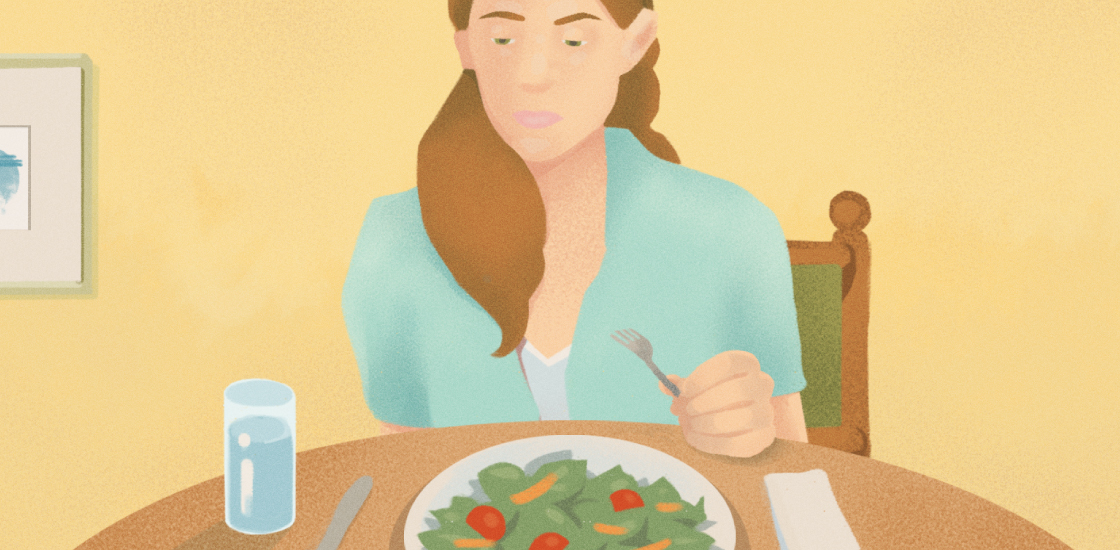THIS ARTICLE IS MORE THAN FIVE YEARS OLD
This article is more than five years old. Autism research — and science in general — is constantly evolving, so older articles may contain information or theories that have been reevaluated since their original publication date.

Listen to this story:
In 1985, a team of researchers in Sweden set out on an ambitious investigation to better understand the nature and course of anorexia nervosa, an eating disorder characterized by disturbances in the experience of the body and dangerous weight loss. The scientists screened the total population of 15-year olds in Göteborg and surrounding regions, and found 51 adolescents who met the criteria for anorexia. A subset of these individuals were also diagnosed with an autism spectrum disorder.
The researchers followed these teenagers for 18 years. Their extensive longitudinal investigation uncovered some tantalizing clues about how autism and anorexia may interact. For instance, in adolescents who have both disorders, anorexia took a longer and more challenging course than it did in those who do not have autism.
These findings prompted researchers to probe deeper into how autism, and the social skill deficits that come with it, might influence the nature of anorexia1,2,3. They realized that the study of interpersonal relationships — and in particular, the barriers to longstanding friendships — might be important in anorexia. A better understanding of these social roadblocks could help researchers develop better treatments for the eating disorder4,5,6.
Just as exploration of the comorbidity of autism and anorexia has led to a richer understanding of anorexia, it may also tell us something about why anorexia often accompanies autism in girls. Anorexia predominantly occurs in girls, affecting four girls for every boy. (Autism shows the opposite pattern, affecting four boys for every girl.)
One theory holds, for example, that refusing food physiologically mutes the confusing array of social and sensory stimuli that occur during adolescence and may be particularly difficult for a girl with autism to handle. A related idea suggests that starvation provides solace during this difficult time by putting the focus on more basic needs, psychologically shutting out other concerns. Certain features of anorexia provide clues to these theories.
Taking control:
In anorexia, individuals are consumed by the experience of their bodies and engage in progressively more severe attempts to lose weight or prevent weight gain. In everyday situations such as having a conversation or listening to a teacher in school, people with anorexia struggle to focus, because they are distracted by how their body feels or by thoughts about food or weight gain.
Yet as researchers and clinicians have learned more about what it feels like to have anorexia, we have discovered motivations for severe weight loss other than wanting to be thin.
The narrative of those with anorexia is uncannily consistent in describing the onset of their disorder: ‘I was feeling out of control and the only thing I had control of was my body.’ This story makes sense in the context in which the disorder typically emerges: adolescence, a period in which life seems increasingly out of control, as relationships grow complicated, the body changes radically and academic demands rise. Though research in this area is limited, one hypothesis is that similar themes may motivate severe food refusal as observed in adolescents with autism.
When these developmental challenges occur in a girl with autism, who is unusually sensitive to and potentially overstimulated by her external and internal sensory worlds, she may more readily turn to food restriction and even starvation to help her cope. One theory holds that starvation and associated weight loss may mute signals and sensations from the body. When starved, the body slows down: The heart beats more slowly, stomach motility decreases and menstrual cycles cease. This slowing may create an illusion of greater predictability in the individual. Thus, girls who are sensitive to their bodies may find comfort in starving.
Hunger pangs:
Another theory invokes the psychologist Abraham Maslow’s Hierarchy of Needs. According to Maslow’s theory, human needs are arranged in a hierarchy, with basic physiological needs such as food and water at the bottom. As the theory goes, these needs must be satisfied before a person turns to personal safety, social needs or nurturing their self-esteem, or seeking to reach her highest potential (self-actualization). That is, people are not motivated to seek higher-level needs until the lower-level needs have been met.
So an individual who is not eating enough food would be stuck at the lowest level. Starvation would sap their motivation for academics, friendships and all the other challenges an adolescent faces.
By narrowing their attention to counting calories, the numbers on the scale or a rigid exercise routine, those with anorexia and autism may feel more in control as other complex concerns fade into the background.
Judging from the narratives, clinical presentation and neurobiological alterations that occur with starvation, both theories have merit. Certainly, many hypotheses for why anorexia emerges invoke starvation as a way to simplify or escape from life’s challenges.
Treatment must address these ideas. Although the primary task is ensuring that the child is eating enough, therapies will not be effective if they do not include tools for coping with sensory sensitivity and the social challenges of adolescence. Treatment should also account for the psychological nourishment food restriction provides and address how to replace that nourishment once a girl starts eating again. In this way, the adolescent will feel heard, understood and respected.
One step in this direction may be to give girls self-assessment questionnaires that measure friendship skills. By identifying an adolescent’s fears or weaknesses, these can point to steps the adolescent can take to improve her relationships with others.
With this and other approaches, a girl can more confidently approach adolescence, embracing its sensory and social complexity rather than feeling overwhelmed by it.
Nancy Zucker is founder and director of the Duke Center for Eating Disorders in Durham, North Carolina.

By joining the discussion, you agree to our privacy policy.